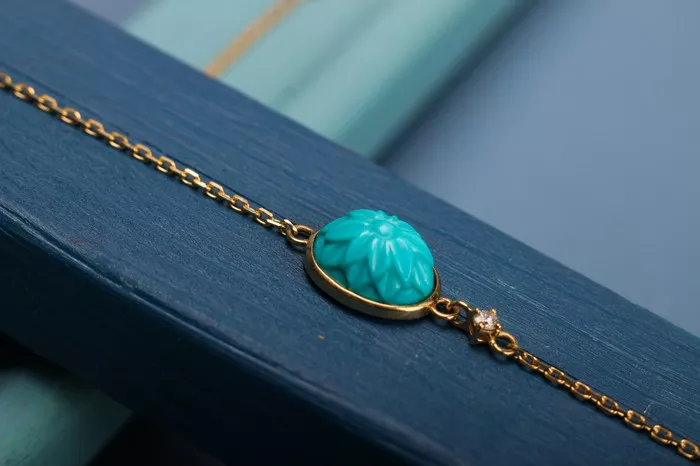Turquoise, with its captivating blue-green hues, has been cherished for centuries as a symbol of wisdom, tranquility, and protection. Whether adorning jewelry or embellishing decorative items, this gemstone exudes a timeless allure. However, despite its beauty, turquoise possesses a delicate nature that requires careful handling and maintenance, particularly when it comes to exposure to water.
Water Sensitivity
Turquoise, like many natural gemstones, is porous, meaning it contains tiny openings that allow substances like water to permeate its surface. This inherent porosity makes turquoise susceptible to water absorption, which can lead to discoloration, weakening of the structure, and even damage over time.
It is crucial for turquoise enthusiasts to understand the gemstone’s water sensitivity to prevent inadvertent harm. Prolonged exposure to water, especially submerging turquoise in water, should be avoided to preserve its integrity and beauty.
Cleaning Tips
Proper cleaning is essential for maintaining the luster and brilliance of turquoise jewelry without compromising its delicate nature. Here are some gentle cleaning tips to ensure your turquoise remains pristine:
Use a Soft Cloth: Begin by gently wiping the surface of the turquoise jewelry with a soft, lint-free cloth to remove any dirt, dust, or oils accumulated from daily wear. Avoid using abrasive materials or harsh chemicals, as they can scratch or dull the gemstone.
Avoid Harsh Chemicals: Refrain from using harsh cleaning agents or ultrasonic cleaners, as they can damage the surface of the turquoise and strip away its natural sheen. Instead, opt for mild soap diluted in lukewarm water if deeper cleaning is necessary.
Gentle Brushing: For stubborn dirt or grime lodged in crevices, use a soft-bristled brush, such as a toothbrush, to gently scrub the surface of the turquoise. Be cautious not to apply excessive pressure, as this can cause abrasions.
Pat Dry: After cleaning, pat the turquoise jewelry dry with a clean, soft cloth to remove excess moisture. Avoid air-drying, as prolonged exposure to water can penetrate the gemstone and cause damage.
Professional Cleaning: For valuable or intricately designed turquoise jewelry, consider seeking professional cleaning services from a reputable jeweler. They have the expertise and specialized equipment to safely clean and restore your precious pieces.
Storage Recommendations
Proper storage is essential for safeguarding turquoise jewelry from environmental factors that can compromise its integrity. Follow these recommendations to preserve the beauty and longevity of your turquoise treasures:
Dry Environment: Store turquoise jewelry in a dry environment away from moisture, humidity, and direct sunlight. Exposure to moisture can accelerate the gemstone’s deterioration, while sunlight can cause fading and discoloration over time.
Jewelry Box or Pouch: Keep turquoise jewelry in a dedicated jewelry box or pouch to minimize exposure to dust, dirt, and other contaminants. Ensure the storage container is lined with soft fabric to prevent scratching or abrasion.
Individual Wrapping: When storing multiple pieces of turquoise jewelry together, wrap each item individually in soft tissue paper or cloth to prevent them from scratching or rubbing against each other.
Avoid Plastic Bags: Refrain from storing turquoise jewelry in plastic bags or containers, as they can trap moisture and promote mold growth, leading to irreversible damage.
Regular Inspection: Periodically inspect stored turquoise jewelry for any signs of damage or deterioration. Promptly address any issues to prevent further degradation and preserve the gemstone’s beauty.
Avoid Swimming or Showering
While turquoise jewelry may add a touch of elegance to your attire, it is essential to exercise caution when wearing it during water-related activities. Here’s why:
Chlorinated Water: Chlorine, commonly found in swimming pools and hot tubs, can react with the surface of turquoise jewelry, causing discoloration and deterioration. Avoid exposing turquoise to chlorinated water to prevent irreversible damage.
Soap Residue: The chemicals present in soap, shampoo, and other personal care products can adhere to the surface of turquoise jewelry, dulling its shine and diminishing its vibrancy over time. Remove turquoise jewelry before showering or bathing to avoid exposure to soap residue.
Abrasive Contact: Activities such as swimming, showering, or washing dishes can subject turquoise jewelry to abrasive contact with surfaces, leading to scratches, chips, or other forms of damage. It is best to remove turquoise jewelry before engaging in such activities to preserve its pristine condition.
Re-Sealing and Re-Polishing
Some turquoise jewelry undergoes treatment with wax or resin to enhance its color, stability, and durability. However, over time, this protective coating may wear off, necessitating re-sealing and re-polishing to maintain the gemstone’s appearance and integrity.
Professional Maintenance: Consider having your turquoise jewelry inspected and professionally re-sealed and re-polished by a qualified jeweler or gemologist. They can assess the condition of the gemstone and recommend appropriate treatment to restore its beauty and protect it from further damage.
DIY Re-Sealing: If you prefer to re-seal turquoise jewelry yourself, use a specialized wax or resin designed for gemstone treatment. Follow the manufacturer’s instructions carefully to ensure proper application and long-lasting protection.
Preventative Measures: To prolong the effectiveness of the protective coating, avoid exposing turquoise jewelry to harsh chemicals, extreme temperatures, or abrasive surfaces that can compromise its integrity. Handle turquoise jewelry with care and store it properly when not in use to minimize the need for frequent re-sealing and re-polishing.
In conclusion, while turquoise jewelry exudes timeless beauty and charm, it requires delicate care and maintenance to preserve its pristine condition. Understanding the gemstone’s water sensitivity, employing gentle cleaning techniques, adhering to proper storage practices, and avoiding exposure to water-related activities are essential steps in safeguarding turquoise jewelry for generations to come. By following these guidelines and investing in regular maintenance, you can enjoy the enduring elegance of turquoise jewelry for years to come.


